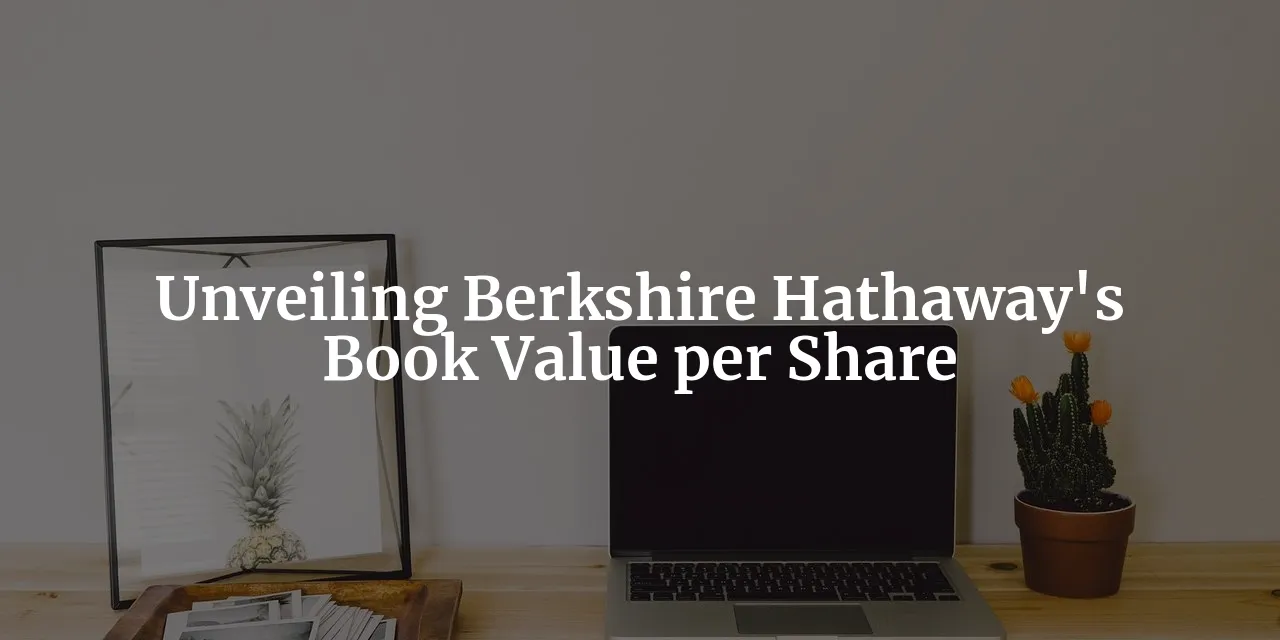This fanpage is not officially affiliated with Berkshire Hathaway: Disclaimer
Attention Berkshire Hathaway shareholders! Are you curious about the book value per share of your beloved company? Look no further, because this article will unveil all the details you need to know. From understanding the unique share structure to performing detailed calculations, we will provide you with a comprehensive understanding of this crucial financial metric. Discover how the book value per share reflects the company's financial health, its resilience during economic uncertainty, and its commitment to delivering value to you, the shareholders. Don't miss out on this opportunity to gain valuable insights and make informed investment decisions. Read on to unlock the secrets of Berkshire Hathaway's book value per share!

Introduction
Berkshire Hathaway, a multinational conglomerate holding company led by the legendary investor Warren Buffett, has long been a beacon of stability and growth in the world of finance ↗. With a diverse portfolio of businesses and investments, Berkshire Hathaway has consistently delivered value to its shareholders. However, to truly appreciate the value that Berkshire Hathaway brings, it's essential to understand the book value per share ↗. This financial metric provides a snapshot of the company's intrinsic value, offering insights into its financial health and performance.
This article aims to demystify Berkshire Hathaway's book value per Class A and Class B shares as of the third quarter of 2023. By delving into the company's share structure and performing detailed calculations, we will provide a comprehensive understanding of this crucial financial metric. The objective is not merely to present numbers but to help shareholders grasp their significance and implications for investment decisions.
The Tale of Two Classes: Exploring Berkshire Hathaway's Share Structure
Berkshire Hathaway's share structure is unique, consisting of two classes of common stock: Class A and Class B. This dual-class structure was implemented to give investors more flexibility and to prevent the creation of unit trusts that would have fragmented Berkshire’s shareholder base. The Class A shares are convertible into 1,500 Class B shares, but the reverse is not true. This one-way convertibility ensures that Class A shareholders can maintain their voting power while also benefiting from the liquidity of Class B shares.
As of September 30, 2023, there were 571,726 Class A shares and a staggering 1,308,414,093 Class B shares outstanding. On an equivalent Class A share basis, this translates to 1,445,546 shares. This calculation is crucial as it allows us to compare the two classes of shares on an equal footing, considering the 1:1,500 conversion ratio.
Unveiling the Book Value per Share: Calculations and Insights
The book value per share is a key financial metric that represents a company's net asset value (assets minus liabilities) divided by the number of shares outstanding. It provides a measure of the underlying value of each share, offering insights into the company's financial health and performance.
Based on the provided data, Berkshire Hathaway's shareholders' equity stood at $525,330M as of Q3 2023 (see Berkshire Hathaway shareholders’ equity in its quarterly financial statement, page 3) . Dividing this by the number of equivalent Class A shares outstanding (1,445,546), we find that the book value per Class A share is approximately $363,412. For Class B shares, considering their economic equivalence to 1/1,500th of a Class A share, the book value per Class B share is approximately $242.
Berkshire Hathaway Shareholder Equity and Book Value Q3 2023
| Category | Amount |
|---|---|
| Total Shareholder Equity | $525,330M |
| Book Value per Class A Share | $363,412 |
| Book Value per Class B Share | $242 |
This comparison reveals a significant disparity in the book value per share between the two classes, primarily due to the conversion ratio. However, it's important to note that this does not necessarily imply a difference in the intrinsic value or financial performance of the two classes of shares.
Shareholders of Berkshire Hathaway: What the Book Value per Share Reveals
For shareholders, the book value per share is a critical measure of the value they hold. It provides a snapshot of the company's financial health, helping investors make informed decisions. The trend of the book value per share over time can also offer insights into the company's performance and growth.
In the case of Berkshire Hathaway, the substantial book value per share for both Class A and Class B shares reflects the company's strong financial position and successful investment strategy. It also underscores the company's commitment to delivering value to its shareholders.
However, it's important for shareholders to consider the book value per share in the context of other financial metrics and the broader market conditions. For instance, during periods of economic uncertainty, the book value per share can provide a measure of the company's resilience and its ability to weather financial storms.
Conclusion
Understanding Berkshire Hathaway's book value per Class A and Class B shares is crucial for shareholders seeking to make informed investment decisions. It provides a snapshot of the company's intrinsic value, offering insights into its financial health and performance.
While the book value per share is a useful metric, it's important to consider it in the context of other financial metrics and the broader market conditions ↗. By staying informed and understanding these financial metrics, shareholders can better navigate the investment landscape and maximize their returns.
Berkshire Hathaway's strong book value per share reflects its successful investment strategy and commitment to delivering value to its shareholders. With its diverse portfolio of businesses and investments, Berkshire Hathaway continues to be a beacon of stability and growth in the world of finance.
References
- www.berkshirehathaway.com: Third Quarter 2023







